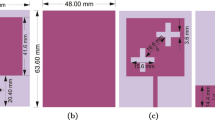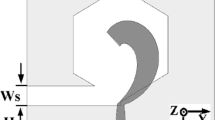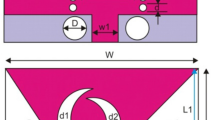Abstract
In this paper, a novel single-feed circular polarized planar antenna with its beam parallel to the substrate plane is discussed. This antenna is composed of two structures: It consists of a vertically polarized magnetic dipole implemented using short-circuited semicircular magnetic disks and a horizontally polarized bended complementary dipole. The entire structure is implemented on a single-layer paper honeycomb substrate with relative permittivity 1.08 and 0.6 mm thickness to resonate at 2.35 GHz. It achieves wide impedance and axial ratio (AR) bandwidths with good overlap and wide beamwidth. It has shown −10 dB impedance bandwidth of 11.5% (2.22–2.49 GHz) and 3 dB AR bandwidth of 11.06% (2.20–2.46 GHz). The proposed antenna would be promising for Wi-Fi or RFID applications.
Access provided by Autonomous University of Puebla. Download conference paper PDF
Similar content being viewed by others
Keywords
1 Introduction
Circularly polarized antennas are very useful in GPS and RFID systems. Circularly polarized antennas with wide beamwidth are required to receive signals from wide range of directions. There are different ways to produce circular polarization (CP) with endfire radiation. Researchers used helical antennas [1,2,3] and achieved endfire radiation over wide beamwidth [4]. Crossed dipole arrays in which the elements are separated by λ/4 distance and fed with equal magnitude, and 90° out of phase inputs were also used to generate CP in endfire direction of the array. However, most of the mentioned antennas are of high profile. Another way to generate CP is using curl antennas [5, 6], where the arms of the antenna are turned around the center of the antenna like a curl. Almost all the antennas produce their beam perpendicular to the substrate plane. In order to have it parallel to substrate plane, there are few methods which either use combination of orthogonal magnetic dipole [7] or combination of aperture/loop with monopole/dipole. Orthogonal magnetic dipoles’ combination is a complex structure with narrow impedance bandwidth. As studied in [8,9,10,11,12] combination of aperture and complementary dipole are employed to realize antenna with endfire beam in the substrate plane. The impedance bandwidths are less [8,9,10,11,12] with highest value <6.5%. This is improved with stub loading [11], but back radiation is increased heavily. This problem is resolved using a v-shaped open loop [12], but the half power beamwidth (HPBW) is 90°. The challenge faced in the design of the microstrip antenna with endfire beam is the structure of the antenna should be simple, compact, and planar. To meet these challenges, in this paper we propose a model which is combination of bended dipole and semicircular magnetic dipole. Good impedance BW and AR characteristics are observed. Radiation pattern with broad beam having HPBW of 125° is achieved.
2 Antenna Geometry
Figure 1 shows the geometry of the proposed antenna which is designed on a 82 mm × 82 mm paper honeycomb substrate of thickness 6 mm and relative permittivity \(\varepsilon_{\text{r}} = 1.08\). It consists of semicircular patches of radius R1 etched on both sides of substrate, and is short-circuited at one end. It is fed with coaxial probe located at a distance L1 from short-circuit end. This antenna also consists a bended complementary electric dipole located at distance L2 and fed using stripline feeding technique from semicircular disk radiator. The complementary electric dipole is bent at angles 60° and 90°.
3 Principle of Operation
CP will be generated when the two orthogonal components of the antenna, i.e., electric fields in azimuthal and elevation planes, are equal. As shown in Fig. 1, two semicircular patches shorted at one end act as a disk radiator (magnetic dipole). It controls the \(\mathop E\nolimits_{\phi }\) component, and complementary electric dipole controls the \(\mathop E\nolimits_{\theta }\) component. For the disk radiator, component of current normal to the edge of the disk approaches to zero at the edge; this implies that tangential components of magnetic field at the edge of the disk are vanishingly small; with these assumptions, it can be modeled as a cylindrical cavity bounded by at its top and bottom by electric walls and on its edge by a magnetic wall. The solution for the wave equation in cylindrical coordinates is
where \(J_{n} (k\rho )\) are the Bessel functions of order n. At the edge of the disk, the surface currents must vanish, i.e.,
where R1 is the radius of the disk and it is determined by the solution of the derivative of the Bessel function
Here n is the wave number given by \(n = 2\pi /\lambda\). \(\lambda\) is the wavelength, \(\mathop J\nolimits_{1}^{'}\) is the first derivative of first-order Bessel, where \(\mathop\upchi\nolimits_{1}^{'}\) is its root. Using above equation, the radius of the disk radiator can be calculated at the desired frequency. The bended open loop is selected to generate a directive \(\mathop E\nolimits_{\phi }\). To analyze radiation behavior, the structure is assumed as combination of ideal short dipoles. It will be clear for the complementary dipole symmetrical about the x-axis; all the x-component fields will cancel each other; only the y-components will be superimposed [12]. The normalized far field of the open dipole antenna is derived as
\(\delta\) is the leading phase in the arms of complementary dipole because of the bent angles B1 and B2 w.r.t to Y-axis.
The field of the proposed antenna is given by
The radiation fields in XZ- and XY-planes are obtained by substituting ϕ = 0° and θ = 90°, respectively, in Eq. (3). Then, the normalized radiation patterns in the XZ-plane can be deduced as
The AR of the elevation plane is given as
We can observe that by substituting \(\mathop E\nolimits_{\phi }\) and \(\mathop E\nolimits_{\theta }\) from (5) and (6) in (7), we can achieve CP radiation with endfire beam in x-direction. The CP direction will be decided by the probe current’s loop/path as shown in Fig. (2). Current from the probe reaches to bended dipole upper arm from upper part of the magnetic disk along the feedline. Then to maintain continuity in the current loop/path, it is considered that displacement current to flow in the +x-direction. After that current turns toward the bottom arm of bended dipole. Then, the current now reaches bottom layer of magnetic disk through the bottom stripline. If this virtual current’s path follows a right-handed helix direction with thumb pointing to +z-direction, the antenna generates right-handed circular polarization (RHCP). Else it generates left-handed circular polarization (LHCP).
4 Design Steps
-
1.
Substrate thickness is chosen to be h = 6 mm to maintain planar configuration of the antenna, which is of low profile, i.e., almost 0.048 times of the guide wavelength \(\left( {\lambda_{\text{g}} } \right)\) at 2.35 GHz, such a way
$$\lambda_{\text{g}} = \frac{{\lambda_{0} }}{{\sqrt {\varepsilon_{\text{re}} } }},\quad \varepsilon_{\text{re}} = \frac{{\varepsilon_{r} + 1}}{2}$$ -
2.
The radius R1 is chosen with the help of Eq. (2) based on the operating frequency.
-
3.
This antenna is fed by a coaxial probe [12]. The feed is located at a distance of R/3 from midpoint of shorting plate. Later, it is optimized to L1 for better results.
-
4.
The length of the stripline pair (L2) is taken to be equal to \(\lambda_{\text{g}} /4\), and the width of the line is chosen to be one-tenth of the height of the antenna.
-
5.
The bended complementary dipole is connected to the stripline feed. Its width is equal to half of the wavelength and has bent angles B1 and B2. These angles are measured from Y-axis.
-
6.
The design is finally optimized to achieve good impedance and axial ratio bandwidths with a broad beam in endfire direction.
5 Simulation Results
The proposed RHCP antenna is designed and simulated using HFSS 17. The impedance, AR, RHCP gain, and total gain of the antenna are observed from the simulation results. Gain of the antenna is 1.83 dB. The impedance bandwidth of the antenna for \(\left| {s_{11} } \right| < 10\) dB is 2.22–2.49 GHz (11.49% in fraction), and the AR bandwidth of \(< 3\) dB is 2.20–2.46 GHz (11.06% in fraction) shown in Figs. 3 and 4, respectively. There is overlap of 240 MHz between the impedance and AR bandwidths. Figures 5 and 6 show the radiation patterns of in XY-plane and XZ-planes, respectively.
6 Conclusion
In this paper, a simple, compact, and planar CP antenna with endfire beam in parallel with substrate plane is proposed. The operating principle and design procedure are explained. Further, the analysis of proposed antenna is described using source model. This antenna provides a good overlap between the impedance bandwidth and AR bandwidth up to 240 MHz and HPBW which are 202° and 125° in elevation and azimuthal planes, respectively. This antenna would be a potential candidate for RFID applications and wireless communication systems with low-elevation angle requirement.
References
J.D. Kraus, Helical beam antennas for wide-band applications. Proc. IRE 36(10), 1236–1242 (1948)
C. Kilgus, Multi element, fractional turn helices. IEEE Trans. Antennas Propag. 16(4), 499–500 (1968)
L.-S. Liu, Y. Li, Z.-J. Zhang, Z.-H. Feng, Circularly polarized patch helix hybrid antenna with small ground. IEEE Antennas Wireless Propag. Lett. 13, 361–364 (2014)
W. Liu, Z. Zhang, Z. Feng, A bidirectional circularly polarized array of the same sense based on CRLH transmission line. Propag. Electromag. Res. 141, 537–552 (2013)
H. Nakano, S. Okuzawa, K. Ohishi, H. Mimaki, J. Yamauchi, A curl antenna. IEEE Trans. Antennas Propag. 41(11), 1570–1575 (1993)
H. Nakano, Natural and metamaterial-based spiral and helical antennas, in Proceedings of Loughborough Antennas Propagation Conference (Loughborough, U.K., 2014), pp. 387–390
W.J. Lu, J.W. Shi, K.F. Tong, H.B. Zhu, Planar endfire circularly polarized antenna using combined magnetic dipoles. IEEE Antennas Wireless Propag. Lett. 14, 1263–1266 (2015)
W.H. Zhang, W.J. Lu, K.W. Tam, A planar end-fire circularly polarized complementary antenna with beam in parallel with its plane. IEEE Trans. Antennas Propag. 64(3), 1146–1152 (2016)
M. Ye, X.R. Li, Q.X. Chu, Single-layer circularly polarized antenna with fan-beam endfire radiation. IEEE Antennas Wireless Propag. Lett. 16, 20–23 (2016)
B. Xue, M. You, W.J. Lu, L. Zhu, Planar endfire circularly polarized antenna using concentric annular sector complementary dipoles. Int. J. RFMicrow. Comp.-Aided Eng. 26(9), 829–838 (2016)
J. Zhang, W.J. Lu, L. Li, L. Zhu, H.B. Zhu, Wideband dual-mode planar endfire antenna with circular polarization. Electron. Lett. 52(12), 1000–1001 (2016)
M. You, W.-J. Lu, B. Xue, L. Zhu, H.-B. Zhu, A novel planar endfire circularly polarized antenna with wide axial-ratio beamwidth and wide impedance bandwidth. IEEE Trans. Antennas Propag. 64(10), 4554–4559 (2016)
R. Garg, P. Bhartia, I. Bahl, A. Ittipiboon, Microstrip Antenna Design Handbook (Artech House Inc., Norwood, MA, 2001)
H.A. Wheeler, Directive loop antenna, U.S. Patent 2 518 736, 1950
J.D. Kraus, Antennas, 2nd edn. (McGraw-Hill, New York, 1988)
Author information
Authors and Affiliations
Corresponding author
Editor information
Editors and Affiliations
Rights and permissions
Copyright information
© 2020 Springer Nature Singapore Pte Ltd.
About this paper
Cite this paper
Manoj Kumar, K., Bharathi, A. (2020). Single-Feed Right-Hand Circularly Polarized Microstrip Antenna with Endfire Radiation. In: Saini, H.S., Singh, R.K., Tariq Beg, M., Sahambi, J.S. (eds) Innovations in Electronics and Communication Engineering. Lecture Notes in Networks and Systems, vol 107. Springer, Singapore. https://doi.org/10.1007/978-981-15-3172-9_5
Download citation
DOI: https://doi.org/10.1007/978-981-15-3172-9_5
Published:
Publisher Name: Springer, Singapore
Print ISBN: 978-981-15-3171-2
Online ISBN: 978-981-15-3172-9
eBook Packages: EngineeringEngineering (R0)










